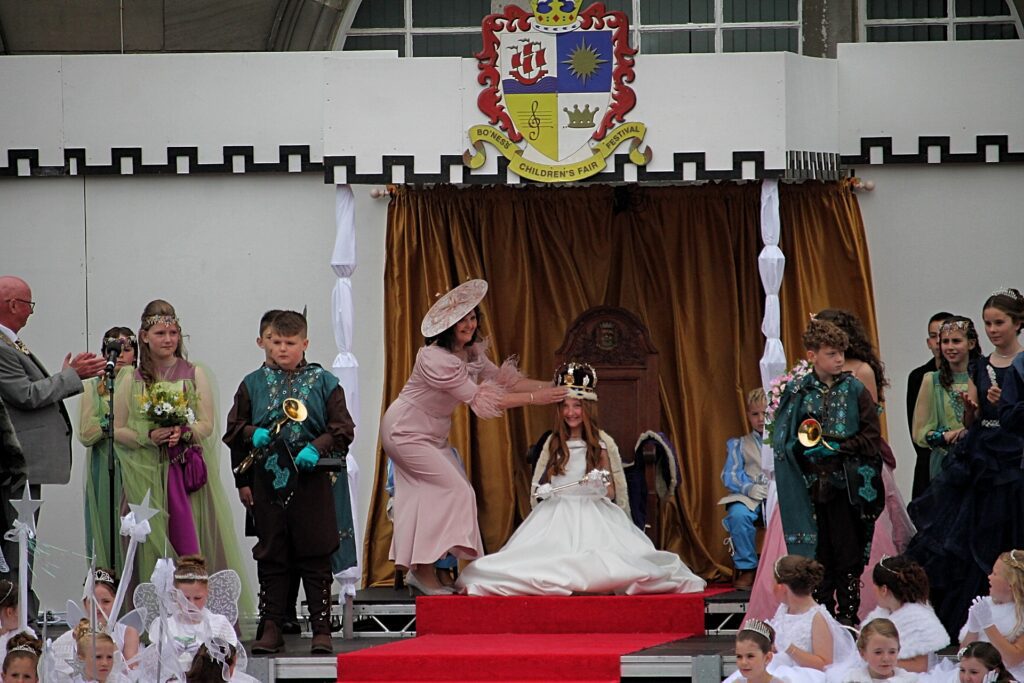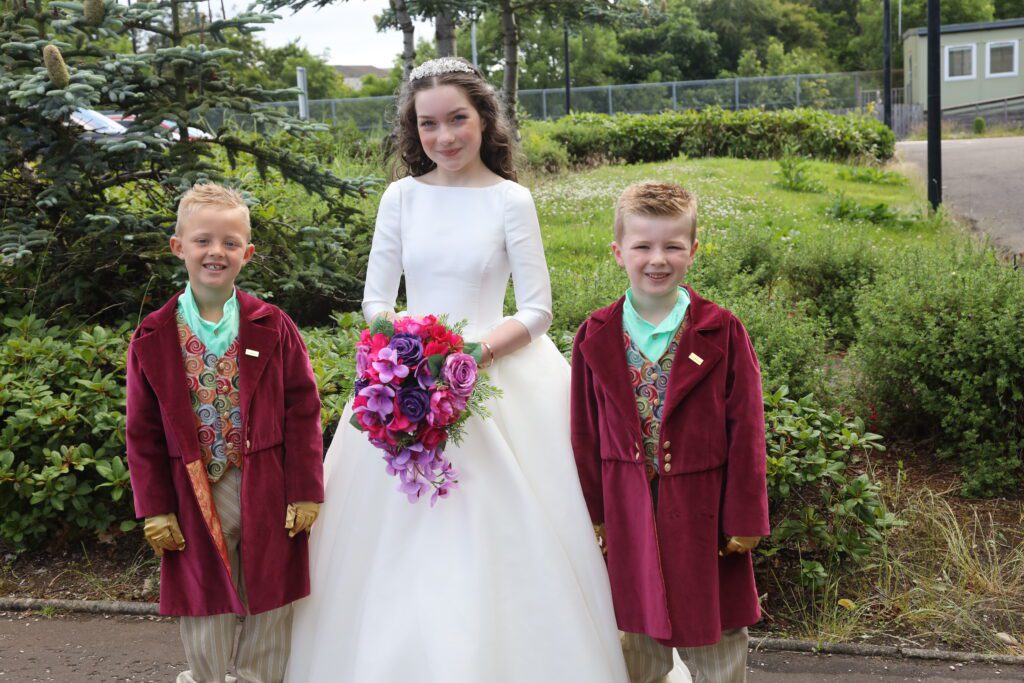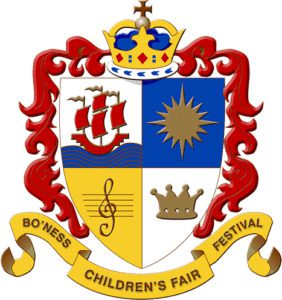With a fanfare of trumpets Deanburn Primary School will this year herald the crowning in the Glebe Park of its first Fair Queen, 12 – year-old Linda Dow. The Coronation of Queen Linda will indeed be an event which Deanburn can justifiably blow about because this will be the first time for sixty-seven years that a new school has had the honour of electing the Fair Queen.
The last occasion on which a new school joined the ranks of those providing the principal characters for the Fair was in fact in 1911 when when the pupils of Grange School elected Ina Ritchie to be their Queen. By then the Fair as we know it as a Children’s Festival, as opposed to the old style miners’ march from which it was descended, was fifteen years old, and looking abck over this period in the Fair’s history it is interesting to note the now almost forgotten little schools which chose the first Queens.
According to the list of former Queens, which appears on page 17 of this issue, the first ever Bo’ness Fair Queen, Grace Stachan, was a pupil of the Academy, but it was a very different Academy to the present 900 pupil Comprehensive School at Grahamsdyke, which has this summer almost doubled in size with the completion of the ultra modern extension, built on the former playing field. For the Academy which Grace Strachan attended was the Anderson Academy, the ruins of which can still be seen on Providence Brae. The Anderson Academy took its name from John Anderson, who was often called “the Uncrowned King of Bo’ness” because of his great influence on the old town in his roles of merchant, banker, landlord, ship owner, and even oil refinery proprietor, and who donated much of his wealth to the erection of the school one year before his death in 1870.
When in 1897 Provost Stewart, seeking a spectacular way to commemorate Queen Victoria’s diamond jubilee, visited Lanark’s famous Lanimer Day celebrations and decided to provide Bo’ness with its own version of these festivities he naturally turned to the Academy as the town’s leading school, to provide the first Queen.
The new style Bo’ness Fair was received with great enthusiasm by the townsfolk who crowded up the braes to Craigallen Park to see Queen Grace crowned by Mrs. Balfour, wife of the Chairman of the Bo’ness School Board. One well known Bo’nessian who had vivid memories of that first Children’s Fair Festival was the late Findlay MacGillivray, and at the age of well over 90 he took a few minutes off from looking after his famous collection of cage birds, to look back and tell me about it.
“It was a really beautiful day, and she was a real bonnie Queen, but it’s the procession I remember best, “he told me as we sat on a bench in his aviary. ” Just as in the old miners’ march,” he continued, “all the trades in the town were represented in the procession. Biggest favourites with the children were the wee pit ponies, which were brought up specially from the pit bottom. The miners were very proud of their ponies, which were beautifully groomed for this the only time in the year they ever saw daylight.
” After they had clipped-clopped by, came five horse drawn decorated lorries entered by the five foundries in the town. Each vied with the other to display the most intricate examples of their craft and on each were patternmakers, actually at work. The potters also worked on their two lorries, which were decorated with model sailing ships, wally dugs, and other china ornaments, made and painted by them.
Even the local football and cricket teams entered that first procession, all mounted on horses hired from the neighbouring farms like the Gauze, the Drum and even North Bank. I wasn’t at all happy about this for I knew very well that these lads, who included my own brother, knew very little about riding, and of course the cheering of the crowd, their own showing off and the steepness of the braes between Craigallan and Kinnigars Park at Carriden where the first Queen’s Revels were held, all combined to make it more and more difficult for them to keep control of their mounts. My worst fears were realised when suddenly my brother’s horse bolted and cannoned into one of the ladies watching the procession go past. By miracle she was not injured, but her new dress was ruined and my brother had to pay for it, which made it a very costly first Fair for him.”
The following year the Queen was again chosen from the Anderson Academy, but then it was decided that each school in the town should take it in turn to provide the Queen and her retinue, a custom which has continued ever since, and so on in 1899 little Borrowstoun School chose Lizzie MacDonald to be its first Queen. It was as a pupil of Borrowstoun School that well remembered Bo’ness school teacher the late Miss Grace Livingston, first went to the Fair, and as she trained later generations of pupils at Bo’ness Public School for their parts in the big day, she often laughingly recalled her picture of herself on her first Fair morning. “Like every other little girl I wore a white frock, and like every other child, girls as well as boys. I wore a cap. Each school had its own distinctive colour of cap and for Borrowstoun it had to be blue and white. Well do I remember my mother’s search for a cap big enough of my head, but they simply did not make school caps in size 7 and 7/8s and so I just had to wear what she could get perched high on top of my bushy hair. It was of course no protection against the boiling sun as we marched from the school down through Newtown to the Glebe Park then all the way to Castleloan for the sports, not to mention walking all the way home again in the afternoon. At the end of that day I remember suffering agonies with a face and neck burned to a brilliant terra-cotta by the sun and the bliss of mother’s old fashioned cure of buttermilk and baking soda.”
Four years later it was again Borrowstoun’s turn to pick the Queen, and Queen Christina Blackwood had little Grace Livingston in her retinue as her Queen of the Fairies, but only after a protest as Miss Livingston loved to remember. “When I heard the result of the voting I immediately said, ‘But what about my poor feet?’ for there were no hurls for fairies in those days. One of my classmates who was much keener on the idea than I was immediately offered to go to the Headmaster and tell him that she would take my place. Within seconds she was back. ‘The Maister says YOU’LL WALK’, She reported, and that was the end of my Fair rebellion. Walk I did, and looking back on that Fair Day I will always recall the story of the little Glasgow pupil who, on being asked by his teacher how he knew when summer had come, replied at once, ‘By the tar bilin’ up in the streets.’ Well, the tar certainly “biled” on that Fair Day, for it was a real scorcher, and my most vivid memory of it is of Miss Duguid, Grange School’s Infant Mistress, wrenching one unfortunate wee girl from the tarry moorings in Corbiehall in which she had become firmly embedded during one of the long halts in the procession.”
While Miss Livingston’s memories of Borrowstoun Fairs were all of sweltering July days, Bo’ness Public School was not so lucky when it came its turn to choose its Queen in 1906. That first Public Queen was Jane Grant, who later became Mrs. J. Jones of Maidenpark, and she remembers wakening on the morning of her big day.
“My mother told me as soon as I woke that it was raining, but of course I kept on hoping that it would go off. All morning, however, it got heavier and heavier, and by 11 0’clock it was simply lashing down, and so I became the only Queen to have her Coronation in the Town Hall. Everyone was so kind to me and said how pretty it all looked under the lights.”
Fortunately the following year the sun did shine again and Mrs Jones was able to wear her beautiful flowered bonnet and carry a parasol, when she surrendered her crown as ex-Queen to Queen Mary Duffy of St. Mary’s School. Queen Mary was St. Mary’s first Queen and with its participation in the festivities the list of schools was almost complete. Only Grange remained to be opened and it was several years before its turn came round to choose Ina Ritchie as its first Queen in 1911.
The opening of the new Grange School meant that older pupils stopped attending Carriden and so after choosing only two Queens, Margaret East in 1901 and Margaret Allen in 1905, it disappeared from the list of schools. Just as Grange School took over Carriden’s senior pupils so it in turn lost its secondary pupils when all secondary, schooling in Bo’ness was centralised at the new Academy when it opened in 1931. Next year the Academy pupils chose Helen Burnett to be their first Queen from the new school in Academy Road, and Grange School from then on chose its Fair characters including its last pre – war Queen, Andrea Walker, from amongst its remaining primary pupils.
The 1930s brought changes in the educational scene not just at the Grange and the Academy, but also at the Public and Borrowstoun. For as the Public took over the old Academy building overlooking the Forth it now had room to accommodate Borrowstoun’s dwindling roll of older pupils and Borrowstoun chose its last Queen, Margaret McMahon, in 1933.
From then on, with the exception of the war years, the regular rota of Kinneil, Grange, Public, St. Mary’s, and the Academy has been used to select the Queen, until now Deanburn is ready to take its place. As a new school it is appropriate that while jealously protecting the old traditions which it so proudly inherits Deanburn also plans to introduce its own novel touches to the proceedings, because it is by thriving on new ideas that the Fair has retained its youthful vigour.
Most striking of the Deanburn innovations will be the appearance of eight State Trumpeters, and as Deanburn is already well known for its excellent school brass band it will come as no surprise to learn that the youngsters will play their own fanfares instead of miming as the heralds have done in former years.
Not only will the heralds take on a new look this year but the Yeomen of the Guard as well, because instead of wearing the customary scarlet beefeater uniforms of the yeomen warders of the Tower, the young Yeomen will this year wear the Yeomen warders’ distinctive but not so well known blue outfits.
New uniforms have also been specially designed for the Lords in Waiting, Crown Bearer, Sceptre Bearer, Sword Bearer, who will wear officers’ dress uniforms featuring the school colours, and Hamilton tartan sashes as a reminder of the school’s close links with Kinneil House, the former home of the Hamilton family, a fact which will also be marked by the Page Boys wearing Hamilton tartan trews.
Completing the picture the Champion will also take on a new appearance as he will be turned out as a trooper in the Life Guards. In keeping with the Life Guards and with Bo’ness Fair tradition the Champion will of course be mounted and oldtimers will bedelighted to hear that Deanburn School hopes to reintroduce more horses into the procession by having four of the eight State Trumpeters mounted.
For many Bo’nessians the traditional Fair E’en round of the arches will be the first time that they have seen Deanburn School in its magnificent setting overlooking the Forth, and the school is therefore going out of its way to lay on an attractive display including a floodlit tableau depicting Snow White and the Seven Dwarfs, a story which Deanburn’s younger pupils will bring to life as presentees on the Fair Day.
Another major part of the school’s decor scheme will be shields bearing the badges of all other schools which have ever contributed Queens to the Fair, and below each shield will appear the names of that school’s Queens. Thus while the pupils of Deanburn School look forward to the crowning of their first Queen, Queen Linda, they will also be encouraged to look back and remember all the other Bo’ness children who have played their parts to keep Bo’ness Fair alive for almost eighty years and to make it Britain’s foremost children’s festival.
UNKNOWN






